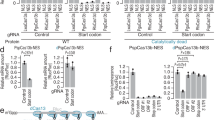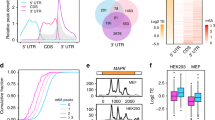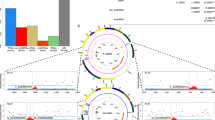Abstract
Bacterial small noncoding RNAs (sRNAs) generally recognize target mRNAs in the 5′ region to prevent 30S ribosomes from initiating translation. It was thought that the mRNA coding sequence (CDS) was refractory to sRNA-mediated repression, because elongating 70S ribosomes have an efficient RNA helicase activity that prevents stable target pairing. We report that the Hfq-associated MicC sRNA silences Salmonella typhimurium ompD mRNA via a ≤12-bp RNA duplex within the CDS (codons 23–26) that is essential and sufficient for repression. MicC does not inhibit translational initiation at this downstream position but instead acts by accelerating RNase E–dependent ompD mRNA decay. We propose an alternative gene-silencing pathway within bacterial CDS wherein sRNAs repress targets by endonucleolytic mRNA destabilization rather than by the prototypical inhibition of translational initiation. The discovery of CDS targeting markedly expands the sequence space for sRNA target predictions in bacteria.
This is a preview of subscription content, access via your institution
Access options
Subscribe to this journal
Receive 12 print issues and online access
$189.00 per year
only $15.75 per issue
Buy this article
- Purchase on Springer Link
- Instant access to full article PDF
Prices may be subject to local taxes which are calculated during checkout






Similar content being viewed by others
Accession codes
References
Waters, L.S. & Storz, G. Regulatory RNAs in bacteria. Cell 136, 615–628 (2009).
Vogel, J. A rough guide to the noncoding RNA world of Salmonella. Mol. Microbiol. 71, 1–11 (2009).
Vogel, J. & Wagner, E.G. Target identification of regulatory sRNAs in bacteria. Curr. Opin. Microbiol. 10, 262–270 (2007).
Gottesman, S. The small RNA regulators of Escherichia coli: roles and mechanisms. Annu. Rev. Microbiol. 58, 303–328 (2004).
Zhang, A., Wassarman, K.M., Ortega, J., Steven, A.C. & Storz, G. The Sm-like Hfq protein increases OxyS RNA interaction with target mRNAs. Mol. Cell 9, 11–22 (2002).
Møller, T. et al. Hfq: a bacterial Sm-like protein that mediates RNA-RNA interaction. Mol. Cell 9, 23–30 (2002).
Sledjeski, D.D., Whitman, C. & Zhang, A. Hfq is necessary for regulation by the untranslated RNA DsrA. J. Bacteriol. 183, 1997–2005 (2001).
Aiba, H. Mechanism of RNA silencing by Hfq-binding small RNAs. Curr. Opin. Microbiol. 10, 134–139 (2007).
Massé, E., Escorcia, F.E. & Gottesman, S. Coupled degradation of a small regulatory RNA and its mRNA targets in Escherichia coli. Genes Dev. 17, 2374–2383 (2003).
Folichon, M. et al. The poly(A) binding protein Hfq protects RNA from RNase E and exoribonucleolytic degradation. Nucleic Acids Res. 31, 7302–7310 (2003).
Moll, I., Afonyushkin, T., Vytvytska, O., Kaberdin, V.R. & Blasi, U. Coincident Hfq binding and RNase E cleavage sites on mRNA and small regulatory RNAs. RNA 9, 1308–1314 (2003).
Mizuno, T., Chou, M.Y. & Inouye, M. A unique mechanism regulating gene expression: translational inhibition by a complementary RNA transcript (micRNA). Proc. Natl. Acad. Sci. USA 81, 1966–1970 (1984).
Bouvier, M., Sharma, C.M., Mika, F., Nierhaus, K.H. & Vogel, J. Small RNA binding to 5′ mRNA coding region inhibits translational initiation. Mol. Cell 32, 827–837 (2008).
Chen, S., Zhang, A., Blyn, L.B. & Storz, G. MicC, a second small-RNA regulator of Omp protein expression in Escherichia coli. J. Bacteriol. 186, 6689–6697 (2004).
Udekwu, K.I. et al. Hfq-dependent regulation of OmpA synthesis is mediated by an antisense RNA. Genes Dev. 19, 2355–2366 (2005).
Argaman, L. & Altuvia, S. fhlA repression by OxyS RNA: kissing complex formation at two sites results in a stable antisense-target RNA complex. J. Mol. Biol. 300, 1101–1112 (2000).
Huntzinger, E. et al. Staphylococcus aureus RNAIII and the endoribonuclease III coordinately regulate spa gene expression. EMBO J. 24, 824–835 (2005).
Maki, K., Uno, K., Morita, T. & Aiba, H. RNA, but not protein partners, is directly responsible for translational silencing by a bacterial Hfq-binding small RNA. Proc. Natl. Acad. Sci. USA 105, 10332–10337 (2008).
Møller, T., Franch, T., Udesen, C., Gerdes, K. & Valentin-Hansen, P. Spot 42 RNA mediates discoordinate expression of the E. coli galactose operon. Genes Dev. 16, 1696–1706 (2002).
Morita, T., Mochizuki, Y. & Aiba, H. Translational repression is sufficient for gene silencing by bacterial small noncoding RNAs in the absence of mRNA destruction. Proc. Natl. Acad. Sci. USA 103, 4858–4863 (2006).
Afonyushkin, T., Vecerek, B., Moll, I., Bläsi, U. & Kaberdin, V.R. Both RNase E and RNase III control the stability of sodB mRNA upon translational inhibition by the small regulatory RNA RyhB. Nucleic Acids Res. 33, 1678–1689 (2005).
Vogel, J., Argaman, L., Wagner, E.G. & Altuvia, S. The small RNA IstR inhibits synthesis of an SOS-induced toxic peptide. Curr. Biol. 14, 2271–2276 (2004).
Kushner, S.R. mRNA decay in prokaryotes and eukaryotes: different approaches to a similar problem. IUBMB Life 56, 585–594 (2004).
Carpousis, A.J. The RNA degradosome of Escherichia coli: an mRNA-degrading machine assembled on RNase E. Annu. Rev. Microbiol. 61, 71–87 (2007).
Morita, T., Maki, K. & Aiba, H. RNase E-based ribonucleoprotein complexes: mechanical basis of mRNA destabilization mediated by bacterial noncoding RNAs. Genes Dev. 19, 2176–2186 (2005).
Guillier, M. & Gottesman, S. The 5′ end of two redundant sRNAs is involved in the regulation of multiple targets, including their own regulator. Nucleic Acids Res. 36, 6781–6794 (2008).
Darfeuille, F., Unoson, C., Vogel, J. & Wagner, E.G. An antisense RNA inhibits translation by competing with standby ribosomes. Mol. Cell 26, 381–392 (2007).
Veèerek, B., Moll, I. & Blasi, U. Control of Fur synthesis by the non-coding RNA RyhB and iron-responsive decoding. EMBO J. 26, 965–975 (2007).
Sharma, C.M., Darfeuille, F., Plantinga, T.H. & Vogel, J. A small RNA regulates multiple ABC transporter mRNAs by targeting C/A-rich elements inside and upstream of ribosome-binding sites. Genes Dev. 21, 2804–2817 (2007).
Takyar, S., Hickerson, R.P. & Noller, H.F. mRNA helicase activity of the ribosome. Cell 120, 49–58 (2005).
Papenfort, K. σE-dependent small RNAs of Salmonella respond to membrane stress by accelerating global omp mRNA decay. Mol. Microbiol. 62, 1674–1688 (2006).
Tjaden, B. et al. Target prediction for small, noncoding RNAs in bacteria. Nucleic Acids Res. 34, 2791–2802 (2006).
Massé, E., Vanderpool, C.K. & Gottesman, S. Effect of RyhB small RNA on global iron use in Escherichia coli. J. Bacteriol. 187, 6962–6971 (2005).
Rasmussen, A.A. et al. A conserved small RNA promotes silencing of the outer membrane protein YbfM. Mol. Microbiol. 72, 566–577 (2009).
Zhang, A. et al. Global analysis of small RNA and mRNA targets of Hfq. Mol. Microbiol. 50, 1111–1124 (2003).
Sittka, A., Pfeiffer, V., Tedin, K. & Vogel, J. The RNA chaperone Hfq is essential for the virulence of Salmonella typhimurium. Mol. Microbiol. 63, 193–217 (2007).
Urban, J.H. & Vogel, J. Translational control and target recognition by Escherichia coli small RNAs in vivo. Nucleic Acids Res. 35, 1018–1037 (2007).
Hartz, D., McPheeters, D.S., Traut, R. & Gold, L. Extension inhibition analysis of translation initiation complexes. Methods Enzymol. 164, 419–425 (1988).
Urban, J.H. & Vogel, J. Two seemingly homologous noncoding RNAs act hierarchically to activate glmS mRNA translation. PLoS Biol. 6, e64 (2008).
Khemici, V. & Carpousis, A.J. The RNA degradosome and poly(A) polymerase of Escherichia coli are required in vivo for the degradation of small mRNA decay intermediates containing REP-stabilizers. Mol. Microbiol. 51, 777–790 (2004).
Viegas, S.C. et al. Characterization of the role of ribonucleases in Salmonella small RNA decay. Nucleic Acids Res. 35, 7651–7664 (2007).
Pfeiffer, V. et al. A small non-coding RNA of the invasion gene island (SPI-1) represses outer membrane protein synthesis from the Salmonella core genome. Mol. Microbiol. 66, 1174–1191 (2007).
McDowall, K.J., Hernandez, R.G., Lin-Chao, S. & Cohen, S.N. The ams-1 and rne-3071 temperature-sensitive mutations in the ams gene are in close proximity to each other and cause substitutions within a domain that resembles a product of the Escherichia coli mre locus. J. Bacteriol. 175, 4245–4249 (1993).
Babitzke, P. & Kushner, S.R. The Ams (altered mRNA stability) protein and ribonuclease E are encoded by the same structural gene of Escherichia coli. Proc. Natl. Acad. Sci. USA 88, 1–5 (1991).
Papenfort, K. et al. Systematic deletion of Salmonella small RNA genes identifies CyaR, a conserved CRP-dependent riboregulator of OmpX synthesis. Mol. Microbiol. 68, 890–906 (2008).
Brodersen, P. & Voinnet, O. Revisiting the principles of microRNA target recognition and mode of action. Nat. Rev. Mol. Cell Biol. 10, 141–148 (2009).
Heidrich, N., Moll, I. & Brantl, S. In vitro analysis of the interaction between the small RNA SR1 and its primary target ahrC mRNA. Nucleic Acids Res. 35, 4331–4346 (2007).
Mackie, G.A. Ribonuclease E is a 5′-end-dependent endonuclease. Nature 395, 720–723 (1998).
Emory, S.A., Bouvet, P. & Belasco, J.G. A 5′-terminal stem-loop structure can stabilize mRNA in Escherichia coli. Genes Dev. 6, 135–148 (1992).
Bouvet, P. & Belasco, J.G. Control of RNase E-mediated RNA degradation by 5′-terminal base pairing in E. coli. Nature 360, 488–491 (1992).
Baker, K.E. & Mackie, G.A. Ectopic RNase E sites promote bypass of 5′-end-dependent mRNA decay in Escherichia coli. Mol. Microbiol. 47, 75–88 (2003).
Joyce, S.A. & Dreyfus, M. In the absence of translation, RNase E can bypass 5′ mRNA stabilizers in Escherichia coli. J. Mol. Biol. 282, 241–254 (1998).
Callaghan, A.J. et al. Structure of Escherichia coli RNase E catalytic domain and implications for RNA turnover. Nature 437, 1187–1191 (2005).
Vytvytska, O., Moll, I., Kaberdin, V.R., von Gabain, A. & Bläsi, U. Hfq (HF1) stimulates ompA mRNA decay by interfering with ribosome binding. Genes Dev. 14, 1109–1118 (2000).
Iost, I. & Dreyfus, M. The stability of Escherichia coli lacZ mRNA depends upon the simultaneity of its synthesis and translation. EMBO J. 14, 3252–3261 (1995).
Dreyfus, M. Killer and protective ribosomes. Prog. Mol. Biol. Transl. Sci. 85, 423–466 (2009).
Sittka, A. et al. Deep sequencing analysis of small noncoding RNA and mRNA targets of the global post-transcriptional regulator, Hfq. PLoS Genet. 4, e1000163 (2008).
Worrall, J.A. et al. Reconstitution and analysis of the multienzyme Escherichia coli RNA degradosome. J. Mol. Biol. 382, 870–883 (2008).
Hüttenhofer, A. & Noller, H.F. Footprinting mRNA-ribosome complexes with chemical probes. EMBO J. 13, 3892–3901 (1994).
Argaman, L. et al. Novel small RNA-encoding genes in the intergenic regions of Escherichia coli. Curr. Biol. 11, 941–950 (2001).
Acknowledgements
We thank G.A. Mackie and B. Luisi for insightful comments on the manuscript and E. Bär for technical assistance. We are grateful for materials from S. Kushner (University of Georgia, E. coli strains), R. Misra (Arizona State University, porin antiserum) and K. Nierhaus (Max Planck Institute for Molecular Genetics, Berlin, 30S ribosomes). This work was supported by a Boehringer Ingelheim Fonds stipend to K.P., by the Biotechnology and Biological Sciences Research Council Core Strategic Grant to J.C.D.H. and by funds of the Deutsche Forschungsgemeinschaft Priority Program SPP1258 Sensory and Regulatory RNAs in Prokaryotes to J.V.
Author information
Authors and Affiliations
Contributions
V.P. and J.V. designed the research; V.P. performed all but the transcriptomic experiments; K.P. and S.L. conducted and analyzed the transcriptomic experiments; J.V. and J.C.D.H. wrote the manuscript, which all authors commented on; J.V. supervised the project.
Corresponding author
Supplementary information
Supplementary Text and Figures
Supplementary Figures 1–6, Supplementary Tables 1–3 and Supplementary Methods (PDF 479 kb)
Rights and permissions
About this article
Cite this article
Pfeiffer, V., Papenfort, K., Lucchini, S. et al. Coding sequence targeting by MicC RNA reveals bacterial mRNA silencing downstream of translational initiation. Nat Struct Mol Biol 16, 840–846 (2009). https://doi.org/10.1038/nsmb.1631
Received:
Accepted:
Published:
Issue Date:
DOI: https://doi.org/10.1038/nsmb.1631
This article is cited by
-
In vivo RNA interactome profiling reveals 3’UTR-processed small RNA targeting a central regulatory hub
Nature Communications (2023)
-
Trans-acting regulators of ribonuclease activity
Journal of Microbiology (2021)
-
Global analysis of sRNA target genes in Mycoplasma hyopneumoniae
BMC Genomics (2018)
-
RNA-binding proteins in bacteria
Nature Reviews Microbiology (2018)
-
Divergence of functional effects among bacterial sRNA paralogs
BMC Evolutionary Biology (2017)



